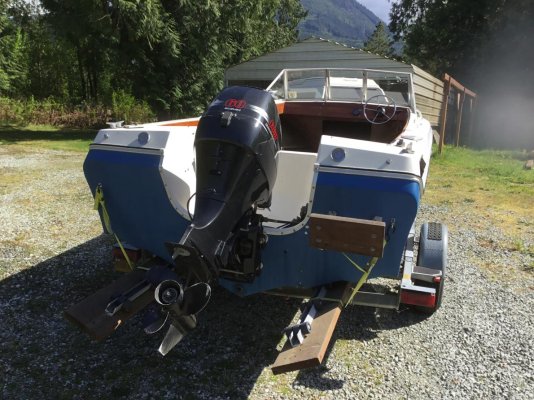On the lake, I owned 5 boats over the years, all inboard-outboards, Mercruisers and Volvo, and read and followed the manuals and over 29 years never had any major problem. However, our lake was heavy in minerals and regular cleaning was required. Outdrives ended up like those used in salt water. The joke on Mercruisers was that the most important tool was the crowbar, only way to remove the lower part of the drive. The Mercury/Mercruiser dealer made you sign that if the housing was damaged when removing it, the replacement cost was on you, not them. However, overall I was very happy with I/O's. Never owned an outboard during that time but my father had them on his fishing boats. Typically in the 40 hp range but no problems.
Bought first outboards for a center console a few years ago, triple 300 hp. Been very happy with them. That boat is used by our employees and gets a lot of use.
Did not bring our I/O to the coast. It wasn't set up for ocean use and they do have versions better equipped. Volvo offers Ocean-X and Mercruiser offers Seacore. While they wouldn't be my first choice, I'd be ok with them in salt water. I didn't choose them on our boat as I didn't foresee the ocean in our future.
The entire reason for I/O's was because you couldn't get the horsepower in outboards. When I started the limit was under 200 hp. Now it's 600. I can't think of a single boat in which an I/O is now a better solution than outboards. All the stern drive builders have added outboard lines and they're leading their sales.
When you get too large for outboards, it's time to go straight to inboards and shafts.
Then comes the big question. When do you choose shafts and when do you go to pods? In my opinion, you only go to pods over 200' for commercial boats. I am not a fan of pods.
The pros and cons. Pods cost more initially and cost more to maintain. Pods are slightly easier to handle and are more efficient so fuel savings plus added speed in the same boat. Pods also take less space. I just personally find shafts so simple and don't find a reason to complicate things. Pods are pushed by many based on the joysticks. I've had shafts with joysticks, several different systems available. I have tested a boat with both systems and liked the way it performed with the pods, but chose the shafts. There are manufacturers using only pods and doing an excellent job of it. I wouldn't refuse their boats because of it even if not my preference.
Now on ocean carriers, pods save significant fuel and the exposure doesn't really matter but just talking moderately sized recreational boats, where did they and where do they fit. Well, they filled a need in many ways better then I/O's. That gave them an opening. However, more, they filled a need on smaller inboards. Both Mercury/Cummins and Volvo started with moderately sized units. That was a big problem. That limited them to 30'-45' in length. You had people like Regal quickly putting triple pods on a 52' boat. It became clear they must increase horsepower. Volvo did so. Mercury/Cummins/Zeus did not and that led to their near demise and ceasing to be a real market factor. Searay doesn't build a boat with pods. That is Mercury saying we don't need them. The Volvo IPS is now viable as a solution up to 80' or so but mostly used 60' and under.
And the diesel outboard, often touted, often suggested, still mostly flounders. Mercury has a 2 stroke 175 hp model that weighs 528 lbs which is only 50 lbs more than their gas model. Cox has a 300 hp model with a five year warranty when used recreationally. Yanmar has a 50 hp diesel outboard built by Neander Shark, a two cylinder common rail engine. OXE is promoting models from 125 to 300 hp. When will one of them actually start selling some volume. I think they need a devoted builder, building only for their motors, a decent line of diesel outboard powered boats.

